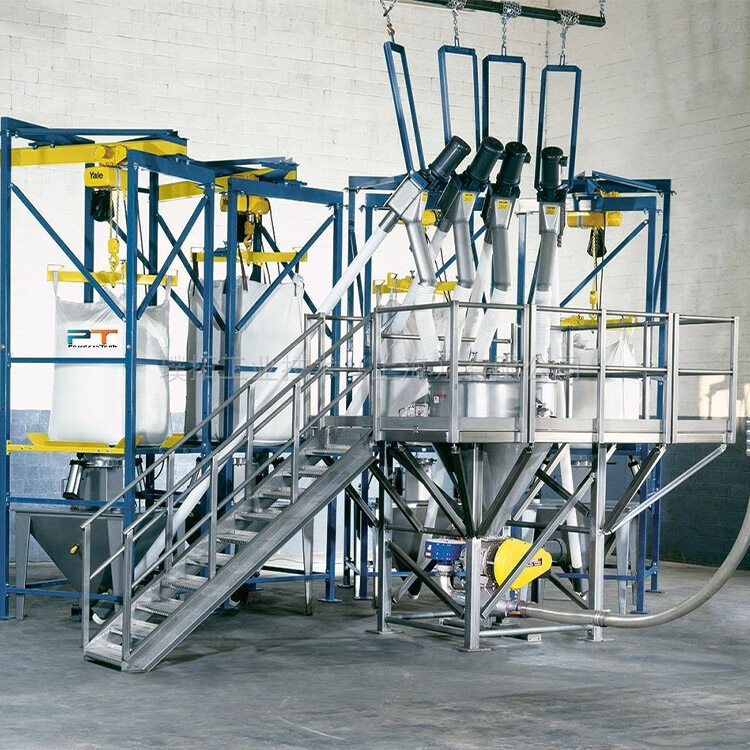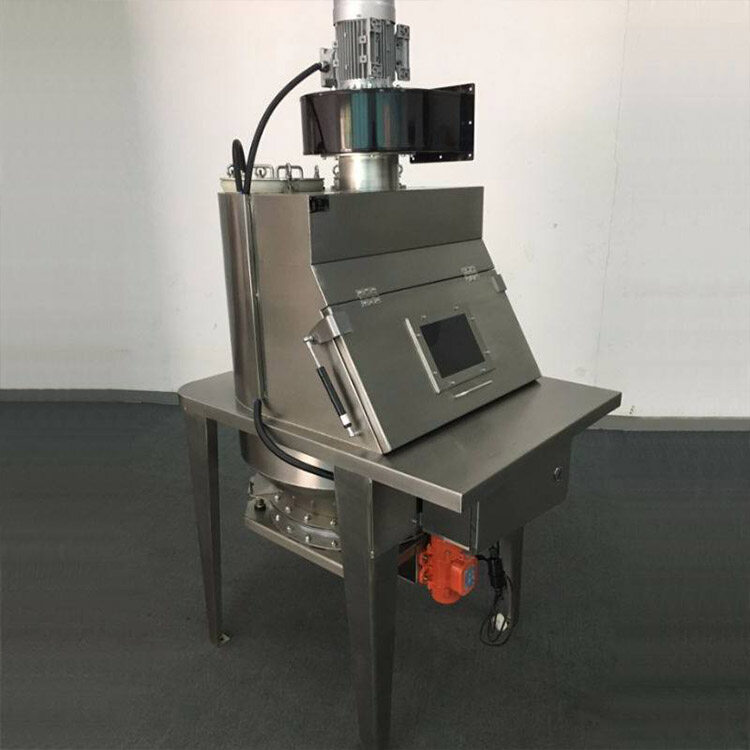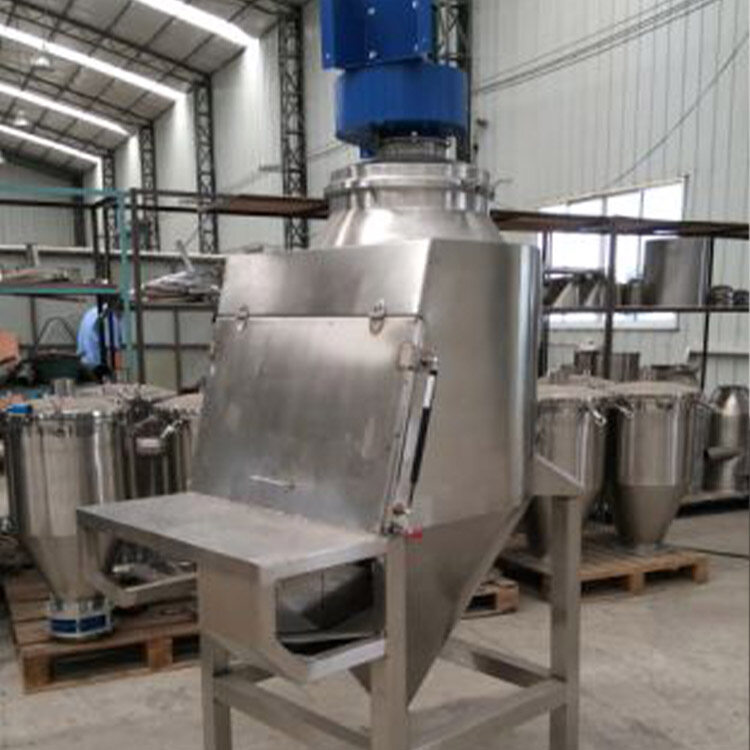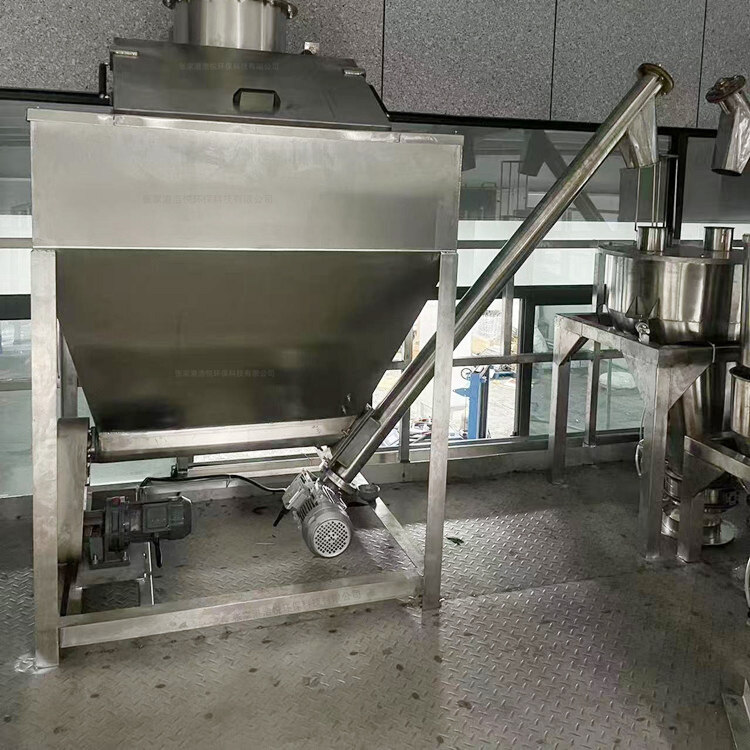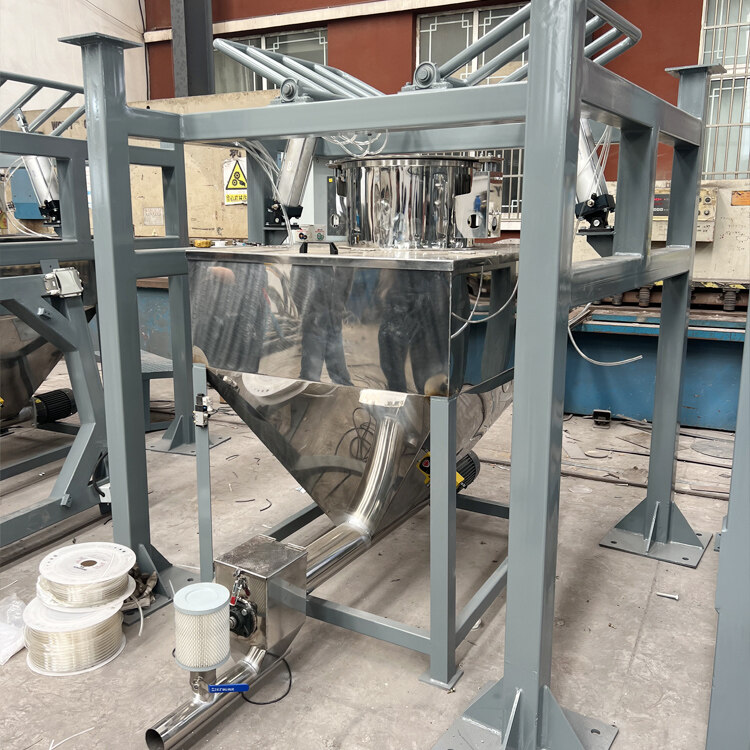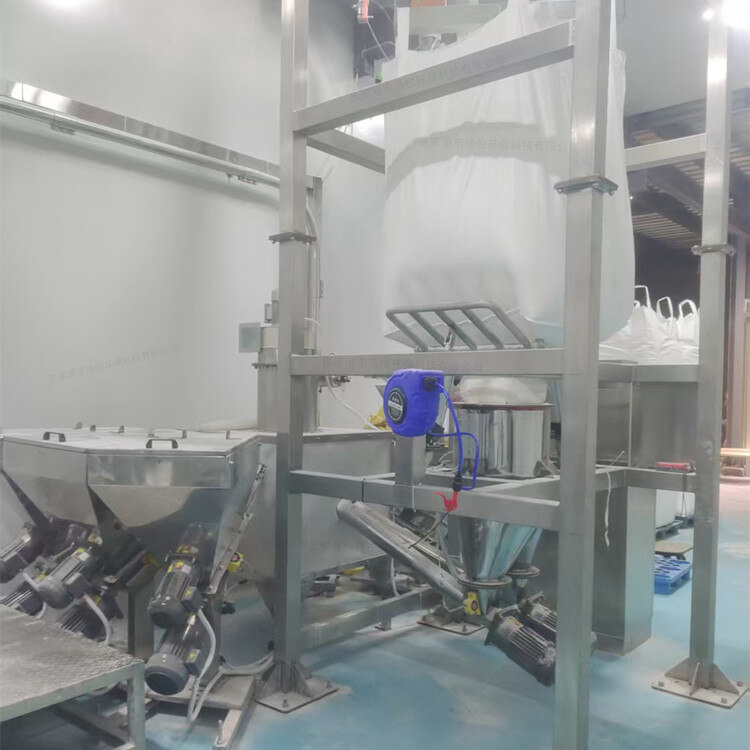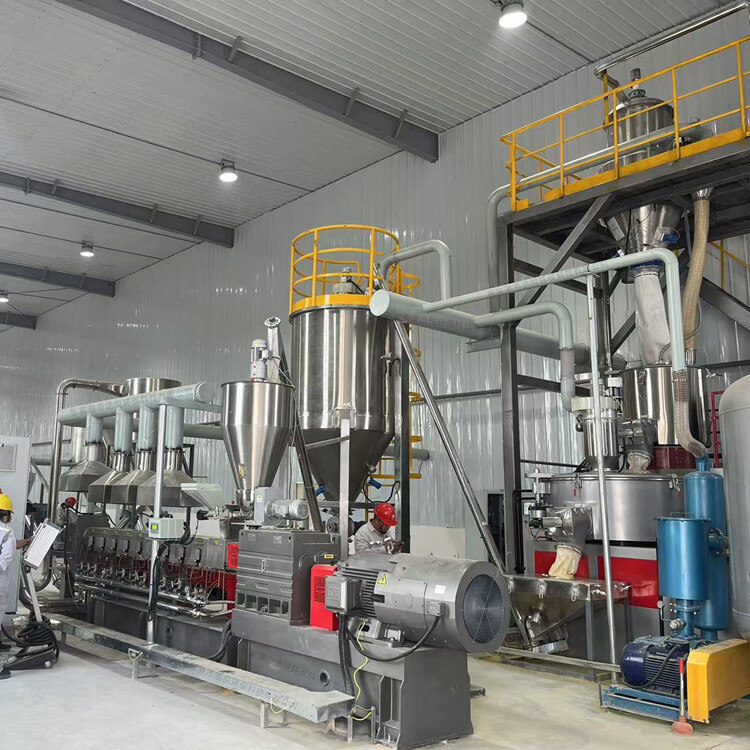- Introduction to automatic batching machine and fully automatic batching machine equipment
- The powder metering system tells you about the introduction of the mixing and drying machine
- 1000kg vacuum feeding machine
- Fully automatic small material batching system
- Research on Innovation of Automatic Weighing Machine Technology
- Design and operation of automatic batching system using PLC, industrial computer and frequency converter
Ton bag dismantling station
- Category:Ton bag unloading station
- Hits:199次
- Release Date:2025-06-23
- Share:
- Inquiry
- Details
The ton bag dismantling station is an automated equipment specifically designed for unloading ton bags (container bags), widely used in industries such as chemical, food, pharmaceutical, building materials, plastics, etc. This equipment replaces traditional manual unpacking with mechanization and automation, effectively solving the problems of low efficiency, high labor intensity, serious dust pollution, and high safety risks of manual unloading, and achieving safe and efficient transfer of materials from ton bags to downstream processes. The following provides a detailed introduction to device functions, structural composition, working principles, application scenarios, and technological development trends.
1、 Core functions and technological advantages
Efficient automated unloading
The ton bag dismantling station can quickly complete the entire process of lifting, positioning, breaking bags, and material placement of ton bags. The unloading time for a single bag is usually controlled within 1-3 minutes, which is 5-10 times more efficient than manual unpacking. The equipment supports continuous operation and is compatible with different specifications of ton bags (with a load capacity of 500-2000kg). Automatic loading of ton bags is achieved through devices such as electric hoists and lifting platforms, reducing the risk of manual handling. Some high-end models are also equipped with automatic bag hanging robotic arms, further enhancing the degree of automation and reducing human dependence.
Environmentally friendly and dust-proof design
In response to the problem of dust pollution that is easily generated during the unloading process of ton bags, the ton bag dismantling station adopts a fully enclosed structure and is equipped with an efficient dust removal system. Sealing devices (such as rubber sealing rings and flexible curtains) are used at the interface between the discharge port and the ton bag to prevent dust from overflowing; The top is integrated with a pulse bag filter or negative pressure suction device, with a dust removal efficiency of over 99%, controlling the dust concentration in the workshop within the safety standard range (such as<10mg/m ³), effectively protecting the health of operators, and complying with environmental regulations. For special industries such as food and medicine, the equipment can also be equipped with HEPA filters to achieve higher levels of dust purification.
Safe and reliable operation
The equipment is equipped with multiple security protection mechanisms to ensure the safety of operations. The electric hoist is equipped with anti fall locking mechanism and overload protection device to prevent accidents caused by the falling of the ton bag; The operation interface is equipped with an emergency stop button and a safety light barrier to prevent personnel from accidentally touching it; For flammable and explosive materials, explosion-proof equipment (Ex certified) can be selected, using explosion-proof motors, explosion-proof control boxes, and anti-static materials to eliminate safety hazards caused by static electricity. In addition, the fully enclosed design of the equipment during operation can effectively prevent material leakage from causing harm to personnel.
Flexible adaptability
The ton bag dismantling station can customize the unloading method according to the material characteristics (powder, particle, block) and downstream process requirements. For materials with poor fluidity, built-in vibrators and arch breaking devices are used to assist in unloading; For high-precision measurement scenarios, it can be linked with weightlessness scales and spiral measuring devices to achieve quantitative feeding; Support seamless integration with downstream equipment such as pneumatic conveying and spiral conveying to meet different production line layouts. At the same time, parameters such as equipment height and discharge port size can be customized to adapt to various specifications of feeding equipment (such as silos, mixers, and reactors).
2、 System composition and working principle
1. Core structural components
Ton bag processing unit
Lifting device: composed of electric hoist, sling, rotating hook, etc., it can achieve vertical lifting, horizontal movement, and 360 ° rotation of the ton bag, facilitating precise positioning of the ton bag. The electric hoist has a variable frequency speed regulation function to ensure a smooth lifting process. Some high-end models are equipped with automatic bag hanging robotic arms, which can automatically grab and hang ton bags without manual intervention.
Bag breaking mechanism: Common forms include manual cutting knives, automatic rotating bag breaking knives, tearing devices, etc. The automatic bag breaking knife is driven by a motor to quickly cut open the bottom or side of the ton bag, with neat cuts and smooth unloading; For ton bags with relatively tough fibers, a serrated tearing device can be used to ensure bag breaking efficiency.
Bracket and lifting platform: High strength steel bracket provides stable support, and the lifting platform (electric/hydraulic drive) can adjust its height to adapt to the feeding port position of different feeding equipment. The platform is equipped with limit sensors to prevent over limit lifting.
Unloading and conveying unit
Unloading hopper: adopts a conical or flat bottom structure, with smooth inner walls (roughness Ra ≤ 0.8 μ m) to prevent material residue. For materials that are prone to clumping, built-in vibration motors, air cannons, or mixers are used to break down material bridges and ensure smooth unloading. The capacity of the discharge hopper is designed based on the capacity of the ton bag, usually 1-3 cubic meters.
Gate control: Material flow can be controlled through manual butterfly valves, electric gate valves, or pneumatic knife gate valves to achieve discharge speed regulation and emergency material cut-off. The valve is made of wear-resistant material with good sealing performance to prevent dust leakage.
Conveyor interface: The bottom of the discharge hopper is equipped with a standard flange interface, which can be connected to screw conveyors, pneumatic conveying pipelines, belt conveyors, etc., to transport materials to designated locations. The interface is equipped with a sealing device to ensure dust-free transportation process.
Dust removal and environmental protection unit
Dust removal system: composed of a suction port, a fan, and a dust collector (such as a pulse bag dust collector). When unpacking, the fan generates negative pressure and sucks the dust generated during unloading into the dust collector for filtration. The purified air is then discharged or recycled for use; The dust collector supports automatic dust cleaning function, which removes dust on the surface of the filter bag through pulse blowing, ensuring continuous and efficient operation.
Sealing component: Elastic sealing material is used at the interface between the ton bag and the discharge hopper, forming a closed space during the discharge process to prevent dust leakage. The overall equipment adopts seamless welding technology to ensure airtightness.
control system
PLC+touch screen: Operators can set lifting height, bag breaking speed, dust removal parameters, etc. through the touch screen; The system displays the real-time running status of the equipment, supports fault code alarms and historical data queries.
Remote monitoring function: Some models support IoT modules, which can remotely monitor device operation through mobile apps or computers, enabling remote fault diagnosis and parameter adjustment, facilitating device maintenance and management.
2. Workflow
Ton bag lifting: Manually or mechanically hang the ton bag onto the electric hoist hook, activate the lifting device to lift the ton bag above the discharge hopper and accurately position it.
Bag breaking unloading: The automatic bag breaking knife cuts open the bottom of the ton bag, and the material falls into the unloading hopper under the action of gravity; If the material has poor fluidity, activate the vibrator or arch breaking device to assist in unloading.
Dust treatment: The dust removal system starts synchronously, and the negative pressure suction port absorbs the dust generated during the unloading process to ensure a clean working environment.
Material transportation: The materials in the discharge hopper are controlled by gates and transported to subsequent processes through downstream conveying equipment (such as screw conveyors).
Empty bag recycling: After unloading is completed, the electric hoist moves the empty bags to the designated location for recycling. The entire process can achieve automated cyclic operations.
3、 Typical application scenarios
Chemical industry: used for unpacking and unloading of chemical raw materials such as polyethylene, polypropylene, carbon black, pigments, etc. The equipment can be made of stainless steel or rubber lining materials, suitable for corrosive materials; Explosion proof design meets the safety requirements for hazardous chemical production.
Food and pharmaceutical industry: Processing materials such as flour, starch, milk powder, pharmaceutical intermediates, etc. The parts in contact with the materials are made of food grade 304/316L stainless steel, with surface polishing treatment, in compliance with hygiene standards such as GMP and HACCP; The fully enclosed structure prevents material contamination, and some equipment supports CIP (in-situ cleaning) function.
Building materials and mining: achieve rapid unpacking of bulk materials such as cement, fly ash, mineral powder, quartz sand, etc., connect with equipment such as mixers and storage bins, and improve the automation level of building materials production lines.
Plastic and rubber industry: used for unpacking and unloading plastic particles and rubber powders, coupled with measuring devices to achieve precise feeding and meet production process requirements.
4、 Technological development trends
Intelligent upgrade: integrating AI visual recognition technology to automatically detect the position and damage of ton bags; Optimizing unloading strategies through machine learning to achieve adaptive control; Introducing digital twin technology to simulate equipment operation status and provide early warning of faults.
Green and energy-saving: Developing low-energy dust removal systems and energy-saving driving devices to reduce equipment operating costs; Made from recyclable materials to reduce environmental pollution; Optimize equipment structure and reduce noise pollution.
Modular design: The equipment adopts standardized modules, supporting quick disassembly and functional expansion, such as adding measuring modules and automatic palletizing modules, to adapt to diverse production needs; Simultaneously facilitating equipment maintenance and upgrades.
The ton bag dismantling station has significantly improved the efficiency and safety of bulk material processing through automation, environmental protection, and safety design, and has become an indispensable key equipment in modern industrial production. With the continuous innovation of technology, its application scenarios will be further expanded, providing strong support for the high-quality development of various industries.


